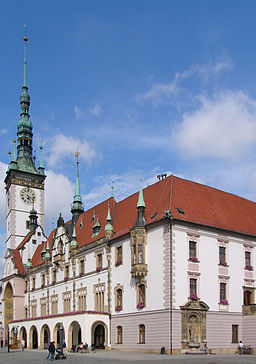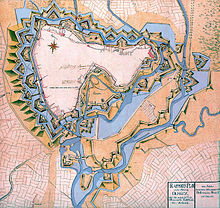Olomouc
Template:Geobox Olomouc (IPA: [ˈolomoʊ̯ts]) (local Haná dialect Olomóc or Holomóc, German Olmütz, Polish Ołomuniec, Latin Eburum or Olomucium) is a city in Moravia, in the east of the Czech Republic. The city is located on the Morava river and is the ecclesiastical metropolis of Moravia.
Architecture of Olomouc

Olomouc contains several large squares, the chief of which is adorned with Holy Trinity Column, a UNESCO World Heritage Site. The column is 115 ft. high and was built in 1716–1754.
The most prominent church is the Saint Wenceslas cathedral. In the end of the 19th century it was rebuilt in neo-Gothic style, but it kept many parts from the original church, which had also been rebuilt many times (Romanesque crypt, Gothic cloister, Baroque chapels). The highest of its three spires is 328 ft. The church neighbours with the Romanesque Bishop’s Palace (often incorrectly called the Přemyslid Palace), a 12th century Romanesque building. (image) The real Přemyslid Palace, i.e. the residence of Olomouc members of the governing Přemyslid Dynasty, used to stand nearby.
The Saint Moritz Church, a fine Gothic building of the 15th century, and the Saint Michael’s Church are also worth mentioning. The Neo-baroque chapel of Saint John Sarkander stands on the place of a former town prison. Catholic priest John Sarkander was imprisoned here in the beginning of the Thirty Years' War. He was accused of collaboration with the enemy and tortured here, but did not reveal anything because of the Seal of Confession, and died. The torturing rack and Sarkander’s gravestone are preserved here. He was canonized by Pope John Paul II during his visit in Olomouc in 1995.
Another place that John Paul II visited here was Svatý Kopeček, a part of Olomouc lying on a hill, with the magnificent Baroque church of the Visitation of the Virgin Mary looking down at the city. The Pope promoted the church to Minor Basilica.
The principal secular building is the town hall, completed in the 15th century, flanked on one side by a gothic chapel, transformed now into a museum. It possesses a tower 250 ft. high adorned with an astronomical clock.
The old university founded in 1573 and suppressed in 1860, was reopened in 1946 and called Palacký University.
Olomouc is also proud of its six Baroque fountains. The fountains survived in such a number thanks to cautious policy of the city council. While most European cities were removing old fountains after they had built their water supply piping, Olomouc decided to keep them as water reservoirs in case of fire. For their decoration ancient Roman motifs were used. Five of them depict Roman gods Jupiter (image), Mercury (image), Triton (image), Neptune (image) and Hercules (image), and one depicts Julius Caesar, the legendary founder of the city. (image)
There are few monasteries in Olomouc, including Hradisko Monastery, Convent of Dominican Sisters in Olomouc and others.
History
Olomouc is said to occupy a site of a Roman fort founded in the imperial period, the original name of which, Mons Julii, would have been gradually corrupted to the present form. Though this is just a legend, archaeological excavations revealed remains of a Roman military camp from the time of Marcoman Wars here.
Olomouc was an important centre of the Great Moravian Empire in the 9th and early 10th century. At a later period it was long the capital of the province of Moravia. The bishopric of Olomouc was founded in 1063, and raised to the rank of an archbishopric in 1777.
In 1306 King Wenceslaus III stopped here on his way to Poland, where he wanted to fight Wladislaus I the Elbow-high to claim his rights to Polish crown, and was assassinated. With his death the whole Přemyslid dynasty died out.


During the Thirty Years' War, in 1640, Olomouc was occupied by the Swedes for eight years. They left the city in ruins and so it ceded its position to Brno. Olomouc was then fortified by Maria Theresa during the wars with Frederick the Great, who besieged the city unsuccessfully for seven weeks in 1758. In 1848 Olomouc was the scene of the emperor Ferdinand's abdication, and in 1850 an important conference between Austrian and German statesmen called Punctation of Olmütz took place here. At the conference German Confederation was restored and Prussia submitted its leadership to the Austrians.
Largely because of its ecclesiastical links to Austria, Salzburg in particular, the city had a German influence since the Middle Ages. It is difficult assess the ethnic makeup of the town before an accurate census was taken. However, official documents from the second half of the 16th century and early 17th century reveal that the town's ecclesiastical constitution, the meetings of the Diet and the locally printed hymnal, were all in the Czech language. Also, the first treatise on music in the Czech language was published in Olomouc in the mid 16th century. The political and social changes that followed the Thirty Years War increased the influence of courtly Habsburg culture. The 'Germanification' of the town was probably more a result of the cosmopolitan environment of the town than by design. As the cultural, administrative and religious centre of the region, it drew officials, musicians and traders from all over Europe. Despite these influences, the Czech language still persisted, particularly in ecclesiastical publications throughout the seventeenth and eighteenth centuries. When the Austrian-born composer and musician Philip J. Rittler accepted a post at the Wenceslas Cathedral in the second half of the seventeenth century, he still felt it necessary to learn Czech. However, the use of the Czech language in official matters went into decline and by the 19th century, the official statistics record that the number of Germans was three times higher than the number of Czechs.[1] Olomouc was enclosed with city walls almost until the end of the 19th century. This suited to the city council, because demolishing the walls would allow extending the city, which would result into settling a lot of Czechs from neighbouring villages. The city council preferred Olomouc smaller, but German. Expansion came after the WWI and establishing Czechoslovakia, when Olomouc integrated two neighbouring towns and 11 surrounding villages and thus gained new space for its growth.
There were serious tensions between the Czech and German-speaking inhabitants during both world wars (largely brought on by outside provocation). During World War II, most of the towns' German residents sided with the Nazis and the German-run town council renamed the main square after Adolf Hitler. The Czech residents changed the name again after the town was liberated. When the retreating German army passed through Olomouc in the final weeks of the war they opened fire on the town's old astronomical clock, leaving only a few pieces (that can now be seen in the local museum). The one that can be seen today is a 1950s reconstruction and features a procession of proletarians rather than saints. Most of the German population was expelled after the war..
Despite its considerable charms, Olomouc has not been discovered by tourists in the same way that Prague, Český Krumlov and Karlovy Vary have. Its inner city is the second-largest historical monuments preserve in the country, after Prague.
One of Olomouc's famous sons was the film-maker Edgar G. Ulmer, who was born in Olomouc in 1904, but who always preferred to give Vienna as his birthplace, as this sounded less provincial. Last year, after months and months of digging in various archives, Bernd Herzogenrath finally was able to locate the address where Ulmer was born in Olomouc. In 1904, the address was “Resselgasse 1, Ort Neugasse.” Today, the name is Resslova 1—Ulmer finally can return to Olomouc! A memorial plaque, designed by artist Bohumil Teplý, commemorating Ulmer's birth home was unveiled on Sept 17, 2006, on the occasion of the ulmerfest 2006 - the First Academic Conference devoted to Ulmer's work (see link below). His daughter Arianné Ulmer-Cipes and her family was present at the event.
Jewish population
The Jewish community began in 906, but were forced into a ghetto in 1060 and to wear a yellow badge. The expulsion order of 1454 was rescinded in 1848, after the revolution. A synagogue was built in 1897, with a Jewish population of 1,676 in 1900 and was destroyed in Kristallnacht on November 10, 1938. Gustav Mahler, composer, and Sigmund Freud lived here for a while. 800 Jewish men were arrested on March 15, 1939 and some were sent to Dachau concentration camp. In 1942-1943, the remaining Jews were sent to Theresienstadt and other German concentration camps in occupied Poland. Only 285 Jews survived the Holocaust.
Sport
The main football club is SK Sigma Olomouc.
- SK Sigma Olomouc - football club
- HC Olomouc - hockey club [1] Template:Cs icon
- Skokani Olomouc - baseball club
- 1. HFK Olomouc - football club
- DHK Olomouc - women handball club [2] Template:Cs icon
Sister cities
Olomouc has several sister cities:
 Antony, Hauts-de-Seine France
Antony, Hauts-de-Seine France Lucerne, Switzerland
Lucerne, Switzerland Nördlingen, Germany
Nördlingen, Germany Pécs, Hungary
Pécs, Hungary Owensboro, Kentucky, USA
Owensboro, Kentucky, USA Subotica, Serbia
Subotica, Serbia Tampere, Finland
Tampere, Finland Veenendaal, Netherlands
Veenendaal, Netherlands
Trivia
- Asteroid 30564 Olomouc was named after this city.
- Olomouc was mentioned in "Disappear," a 2001 song by R.E.M. from their album Reveal.
- Doctor Zhivago (2002 miniseries) was filmed in Olomouc.
See also
Footnote
- ^ Tichák, Milan (1997). Vzpomínky na starou Olomouc. Olomouc: Votobia. p. 13. ISBN 80-7198-184-2.
External links
- Olomouc - Czech.cz, official portal of the Czech Republic
- Municipal website (cz, en)
- UNESCO World Heritage Site: Holy Trinity Column
- Palacký University
- A guide around Moravia Region. English, German, Russian, French, Spanish, Italian, Chinese
- Moravian college
- Filmmaker Albert Maysles in Olomouc
- Info on Ulmer and programme of the ulmerfest 2006
- Tramway in Olomouc (English, German)
Webcams
- Olomouc town hall with an astronomical clock
- Horní náměstí (Upper Square) with the Holy Trinity Column
- Horní náměstí (Upper Square)
Portals
- www.Olomouc.eu - City of Olomouc, official portal.
- Olomouc - travel information, basic facts, hotels, sights
- Portal covering Olomouc
- English-language Olomouc portal
- Another Olomouc portal
- Portal for Olomouc Students
- Official portal for tourist - informations, services, leisure time, monuments, culture - Čeština | English | Deutsch | Français | Espańol
- ...Welcome to Olomouc, city of good cheer... English, Deutsch, Français, Espańol, Italiano, Polski, Russia, Japan, Chinese
- Regional Centre of Olomouc
